11 Tips for How to Make Perfect Norwegian Lefse
One of Norway’s most beloved staple foods is lefse. Lefse is a thin, soft flatbread, made primarily either of wheat or potatoes.
When wheat mills emerged in the 1200s, Norwegians gained access to large amounts of flour. And it was more practical to store stacks of flatbread than bags of flour, so Norwegians began making and storing lefse, to be softened in water when eaten.
Traditionally lefse was made mostly of flour, but in the 1800s when potatoes came to Norway, Eastern Norwegians began mixing in potatoes as well to create potato lefse.
The lefse is rolled out into a large circle and cooked on a large steketakke, or griddle. Though you can also roll out smaller lefser (lefser is the plural of lefse) to cook in a large frying pan instead. Or you can make the smaller slightly thicker potato lefse called lompe. I’ve shared my potato lompe recipe here.
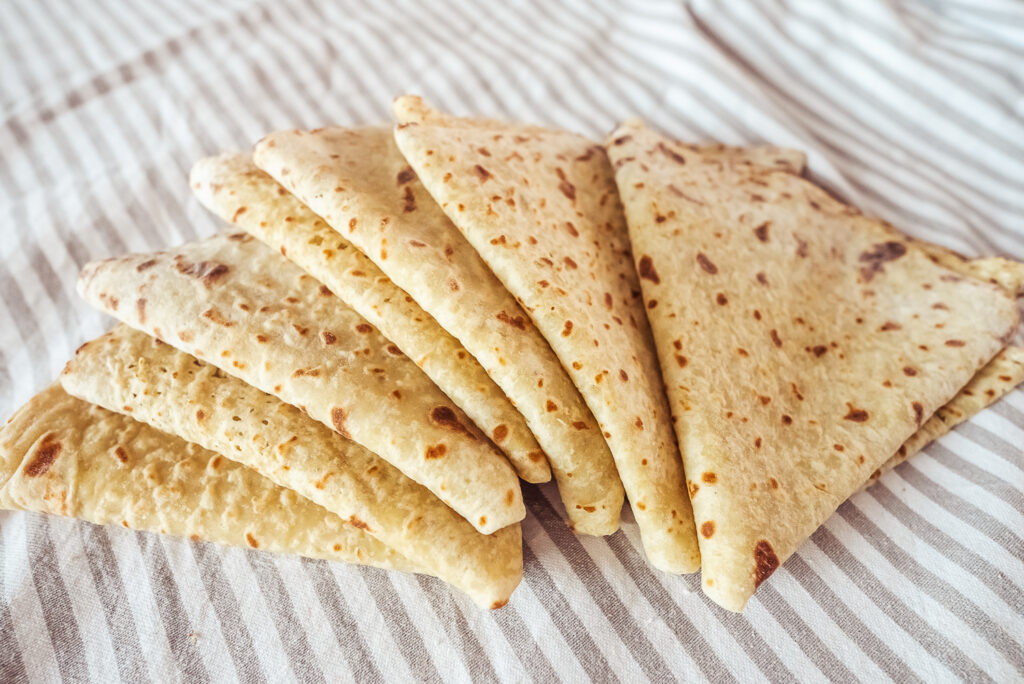
I’ve shared my potato lefse recipe here and my Telemark wheat (flour + semolina) recipe here. But making lefse can be tricky, especially if you do’t have much practice, so I thought today I’d share all my tips for making delicious thin lefse at home.
I’ve also made a video with these tips, including video snippets of me following each tip while making my own lefse. I hope this is helpful, and feel free to leave a comment if you have any questions!
Lefse, lefsa, or lefser
If you don’t speak Norwegian, you might not know the difference between lefse, lefsa, and lefser. These are all different declinations of the same noun! Ei lefse translates to a lefse, den lefsa translates to the lefse, and lefser is the plural of lefse. So this recipe shows you how to make a lefse, how to fill the lefsa with kling, and at the end you will be able to enjoy all the lefser that you made!
Lefse equipment
You do need some special equipment to make lefse. Simplest would be to buy a lefse starter kit like this one on Amazon, which has everything you’ll need to make Norwegian lefse. But if you don’t have a lefse kit, here is what you will need to make lefse:
1. Traditionally we cook lefse on a large steketakke or griddle. I use a 46 cm (18 inch) griddle for my lefse. You can buy a griddle on Amazon here. And of course you can use your griddle to make other things as well, like pancakes and tortillas. But if you don’t have a griddle, you can simply make smaller lefse and cook them in a large dry frying pan instead.
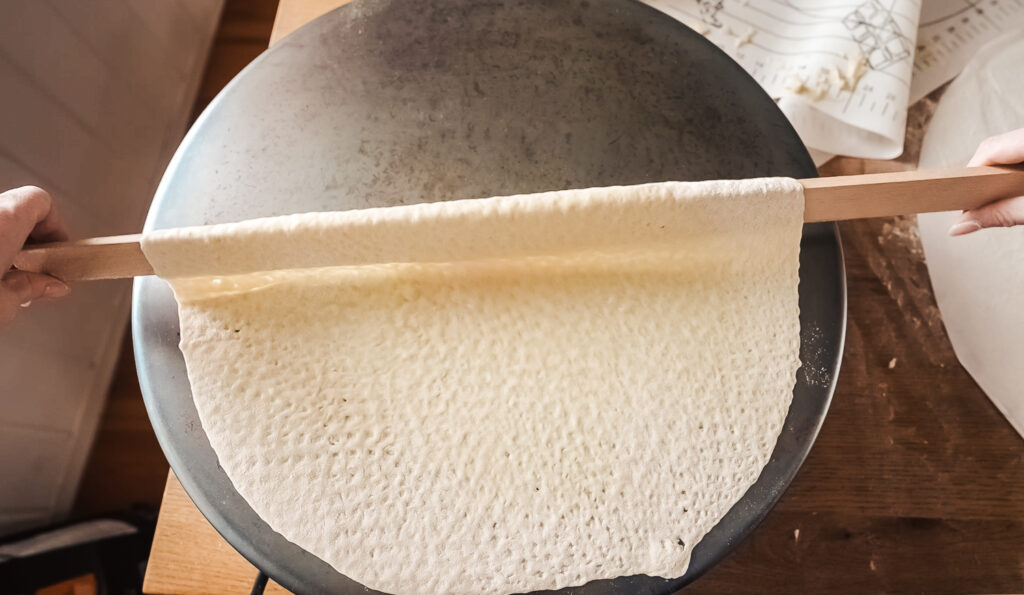
2. You will also need both a regular smooth rolling pin and a corrugated rolling pin. The corrugated rolling pin will help you to roll the lefse quite thin without it breaking or sticking. You might be able to get away with using a regular rolling pin instead, but then you likely won’t be able to get the lefse very thin.
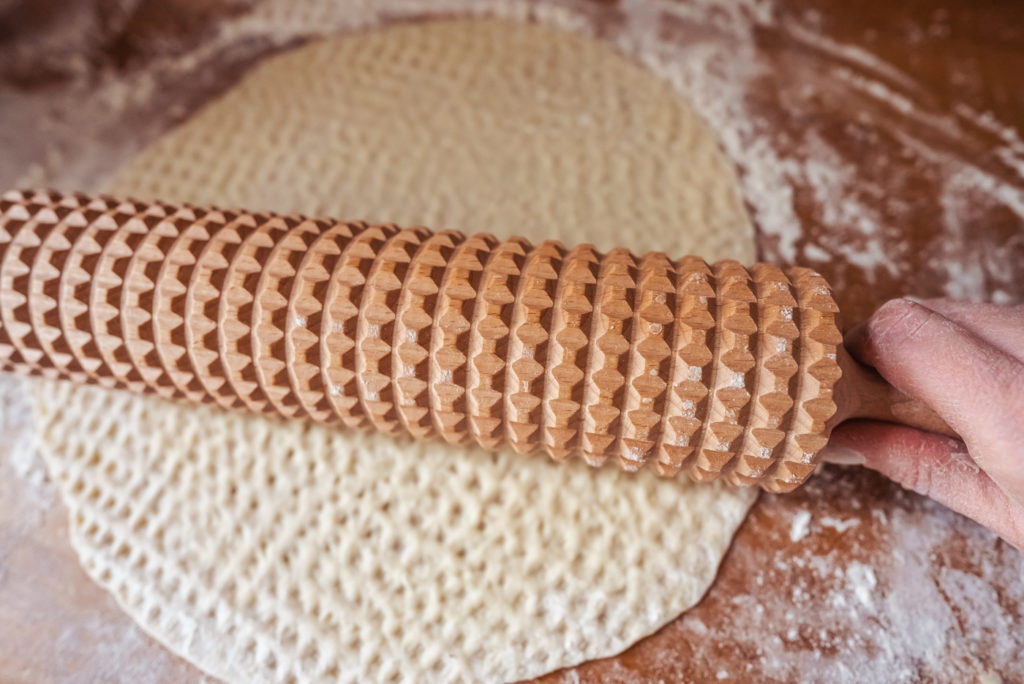
3. You will need a long wooden lefse stick to turn the lefse. This isn’t entirely necessary if you’ll be making small lefser on a frying pan, but if you’re making large lefser on a griddle then a lefse stick is essential.
4. You’ll need a pastry cloth to roll out the lefser. In Norway we actually often simply use the back of a cheap vinyl tablecloth to roll out our lefser. You can cut the tablecloth into a circle slightly larger than your griddle or frying pan, so you know about how large to roll out the lefse.
Tips for making lefse
1. Boil the potatoes with the skins on. In Norway we eat a lot of boiled potatoes, and we always cook them with the skins on to preserve the nutrients. Then we start each meal by peeling our potatoes with a knife and fork. This is why at Norwegian homes you’ll usually see a small plate beside your large dinner plate. No, it’s not for bread – it’s for your potato peels! (In restaurants they’ll peel the potatoes before serving them to you.)
2. When the peeled potatoes are still warm, run them through a potato ricer twice. This ensures that there are absolutely no lumps, and it makes it easier for you to knead the dough later on without overworking it.
3. After ricing the potatoes, let them cool completely in an uncovered bowl in the fridge so that all the excess moisture evaporates. Some people leave the potatoes in the fridge overnight, however I don’t find that necessary.
4. After adding the butter, cream, and flour, knead the lefse dough by hand, not in a machine. You want to knead it until it’s not too sticky to roll out, however you do NOT want to knead it too much.
5. You can check if the lefse dough is ready to roll out by rolling the dough into a long sausage and pressing your thumbs into it. If your thumbs come out clean it’s ready, but if they stick to the dough then you should knead it some more and maybe add more flour.
6. When rolling the dough into individual patties, make sure to take the time to roll them into nice circles. This step is crucial if you want to roll your lefser into nice, round circles. Divide the lefse dough into sections and then roll each section into a nice ball, and flatten the ball with your hand. Use the edges of your hands to cup the dough into a circle without any cracks.
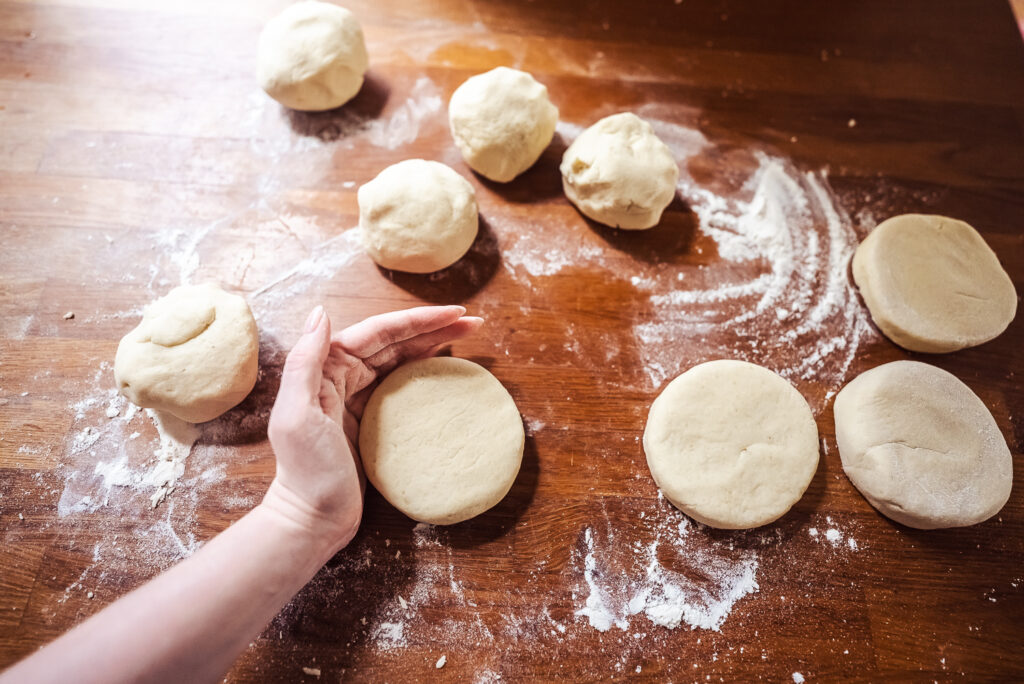
7. Roll out the lefser on a well floured pastry cloth. In Norway we actually often simply use the back of a cheap vinyl tablecloth. Cut the tablecloth into a circle slightly larger than your griddle or frying pan, so you know about how large to roll out the lefse.
8. Start rolling out the lefse with a smooth rolling pin, and then flip the lefse once and switch to the corrugated rolling pin. Some people like to use a rolling pin cover to prevent sticking, but I don’t find it necessary. Use light strokes and concentrate on the edges of the lefse instead of the center, as you don’t want the center to stick.
9. When rolling the lefsa onto your lefse turning stick, be careful not to pull or stretch the lefsa. Gentely turn the stick with your hand. And the same goes for unrolling the lefsa onto the griddle. Don’t stretch the lefsa across the griddle. Instead gently unroll the lefsa and let it drop onto the griddle.
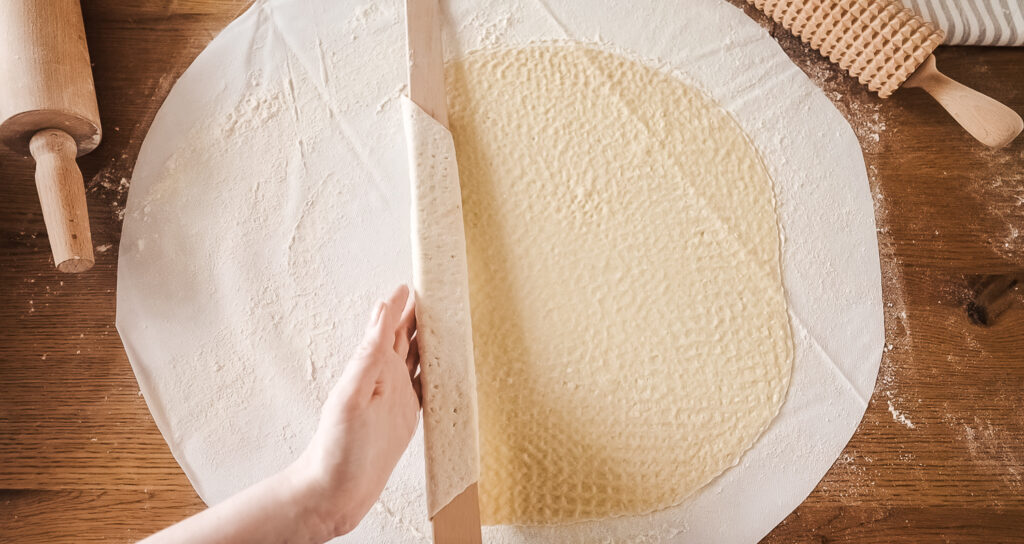
10. Stack your cooked lefser on top of each other in a dampened sheet or tablecloth. Once they’re cool I fold them and store them in a plastic bag.
11. If you’re filling your lefse with kling or other fillings, place the smooth (prettier) side of the lefse face down on your counter, so that is the side you see when you fold the lefse.
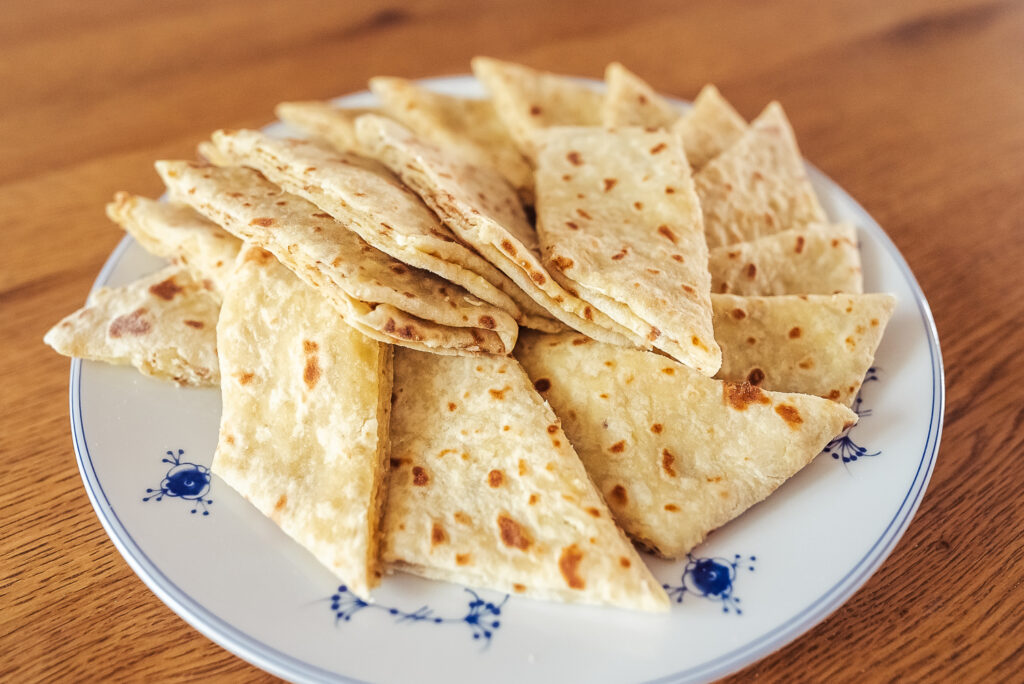
And here’s my favorite Norwegian potato lefse recipe:
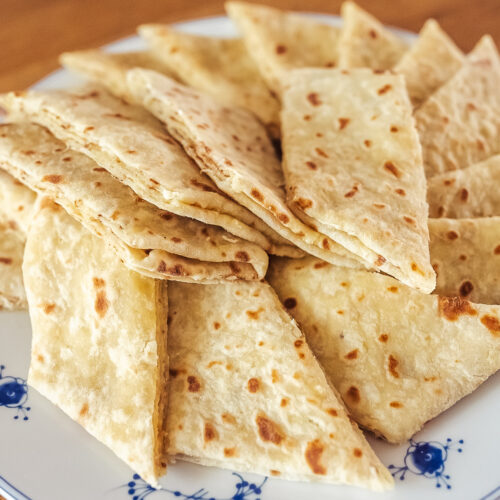
Norwegian Potato Lefse
Equipment
- potato ricer
- Rolling Pin
- corrugated rolling pin
- wax tablecloth or canvas (optional)
- lefse stick
- griddle (or large frying pan)
Ingredients
- 3 lb potatoes
- t tsp salt
- 1 tsp sugar
- 1/4 cup melted butter
- 1/4 cup heavy cream
- 1 and 1/2 cups all purpose flour
- 1/2 cup flour for rolling
(Optional) Kling filling
- 14 tbsp butter (room temperature)
- 3/4 cup granulated sugar
- 1 tbsp heavy cream
Instructions
- Boil the potatoes. Peel the potatoes while still warm and run them through a potato ricer twice.
- Let the potatoes cool in an uncovered bowl in the fridge.
- Stir the salt, sugar, melted butter, and cream into the riced potatoes.
- Slowly add the flour and knead by hand until you get a good consistency. Don't add more flour than necessary! Roll the dough into a long sausage and divide into about 7 or 8 pieces if using an 18 inch griddle. If using a smaller griddle or frying pan, divide the dough into 10 – 12 pieces.
- Roll each piece into a ball and then press into a flat circle, using the edges of your hands to form the dough into a nice circle shape without any cracks. This is important, otherwise you won't get round lefser.
- Heat up your griddle on medium/high heat.
- Flour your rolling surface and roll the lefse dough into a large circle slightly smaller than your griddle or frying pan. Begin rolling with a smooth rolling pin, then switch to a corrugated rolling pin as the lefse gets thinner. Don't use too much flour, as then the edges can become hard.
- Roll the lefse onto your lefse stick and then gently unroll it onto your griddle. After a minute or two check the underside of the lefse for brown spots and then use the lefse stick to flip the lefse and cook on the other side.
- Use the lefse stick to remove the lefse from the griddle and place it in a folded damp sheet or tablecloth.
Kling
- Mix the softened butter, sugar, and cream together until smooth.
- Spread the butter mixture in a very thin layer across the lefse. Fold the edges of the lefse in to make a rectangle (see video). Then cut two triangles from another lefse to cover the empty sections.
- Spread another thin layer of the butter sugar mixture across the rectangle. Fold the rectangle in half and then cut into small rectangles to serve.
- Store the lefse with kling in an plastic bag in the fridge or freezer.
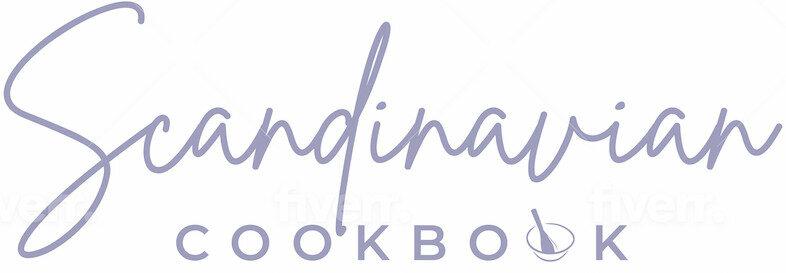
1 Comments
Joan
December 25, 2024 at 1:42 am
Just want to thank you for this recipe.
For the record, I took 3 lb 5 oz of unpeeled russets, peeled, and weighed again: 2 lb 14 oz. I cut them up in pieces about 1x1x2″, soaked (to remove at least some starch) 45 min, drained, rinsed, then steamed rather than boiling – again, an effort to reduce water content and stickiness. The end result was 5 c of riced potatoes. I mixed in everything except flour, which I added only after the rest of the ingredients were thoroughly chilled, and all steam and excess humidity was allowed to evaporate. I used only 1 c flour – you did say to use as little as possible – and mixed it minimally to prevent the formation of too-strong gluten strands.
The result was perfectly tender lefse: the best I’ve ever made. Thanks again!